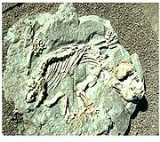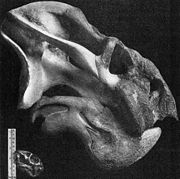
Diictodon
Encyclopedia
Diictodon was a genus of therapsid
, roughly 45 cm (18 inches) long. It belonged to the sub-group Dicynodont
ia. These mammal-like synapsids lived during the Late Permian
period, approximately 255 million years ago. Fossils have been found in Africa and Asia (in fact, roughly half of all Permian vertebrates found in South Africa are that of Diictodon). This small herbivorous animal was one of the most successful synapsids in the Permian period.
 Diictodon had disproportionally large heads that ended in a horny beak. Both males and females had a pair of tusks sticking out from the upper jaw, with those of the male being slightly larger. Diictodon had strong arms and legs, as well as 5 sharp claws on each hand, and may have had keen senses of smell and sight. Their gait was similar to the 'high walk' of crocodiles. Their jaws were also simplified, with some of the bones dedicated instead to hearing, considered a key sign of mammalian adaptation.
Diictodon had disproportionally large heads that ended in a horny beak. Both males and females had a pair of tusks sticking out from the upper jaw, with those of the male being slightly larger. Diictodon had strong arms and legs, as well as 5 sharp claws on each hand, and may have had keen senses of smell and sight. Their gait was similar to the 'high walk' of crocodiles. Their jaws were also simplified, with some of the bones dedicated instead to hearing, considered a key sign of mammalian adaptation.
Diictodon also had many adaptations for digging, such as highly developed muscles, a cylindrical body, and wide hands.
in the Late Permian Period. Inside these burrows, nests have been found, where Diictodon skeletons are present. They were social and gregarious, and lived together, with numerous burrows in 500 square meters of space. However, their burrows were unconnected and did not form any large colonies. Many Diictodon nested close to flood plains, and some specimens may have been killed as water flowed into the nests, drowning the animals. Diictodon had no known rival species competing in its niche, so they may have competed primarily with others of their species for the little plant material available.
s, Diictodon were herbivorous. They used their beaks to break off pieces of the sparse desert shrubs. Like modern desert animals, Diictodon may have had unusually efficient digestive systems, due to the lack of nutrients present in desert plants. As burrowing animals, they may have fed off of water-rich plant tubers (roots).
 Diictodon was a dicynodont
Diictodon was a dicynodont
, and therefore only distantly related to the Cynodont
s that eventually evolved into Mammal
s. Some evolved into larger species. These dicynodont
s, such as Lystrosaurus
and Placerias
dominated the earlier part of the Triassic
period. However, they were out-competed by prosauropod dinosaur
s in the Norian.
mammal-like reptiles and Lystrosaurus
, a Triassic
mammal-like reptile or dicynodont
in Walking With Monsters
. They also made several appearances in the third season of the TV series "Primeval
", two of them being kept as pets by the main characters.
Therapsida
Therapsida is a group of the most advanced synapsids, and include the ancestors of mammals. Many of the traits today seen as unique to mammals had their origin within early therapsids, including hair, lactation, and an erect posture. The earliest fossil attributed to Therapsida is believed to be...
, roughly 45 cm (18 inches) long. It belonged to the sub-group Dicynodont
Dicynodont
Dicynodontia is a taxon of anomodont therapsids or mammal-like reptiles. Dicynodonts were small to large herbivorous animals with two tusks, hence their name, which means 'two dog tooth'...
ia. These mammal-like synapsids lived during the Late Permian
Permian
The PermianThe term "Permian" was introduced into geology in 1841 by Sir Sir R. I. Murchison, president of the Geological Society of London, who identified typical strata in extensive Russian explorations undertaken with Edouard de Verneuil; Murchison asserted in 1841 that he named his "Permian...
period, approximately 255 million years ago. Fossils have been found in Africa and Asia (in fact, roughly half of all Permian vertebrates found in South Africa are that of Diictodon). This small herbivorous animal was one of the most successful synapsids in the Permian period.
Appearance

Diictodon also had many adaptations for digging, such as highly developed muscles, a cylindrical body, and wide hands.
Lifestyle
As a therapsid, Diictodon shared many features with modern day mammals. Most noticeably, they made burrows into the earth. These burrows could be up to 1.5 m (5 feet) deep. Many scientists believe that Diictodon lived like the modern gopher. These could have been used to escape the heat of the desert, which was the dominant environment on the continent of PangaeaPangaea
Pangaea, Pangæa, or Pangea is hypothesized as a supercontinent that existed during the Paleozoic and Mesozoic eras about 250 million years ago, before the component continents were separated into their current configuration....
in the Late Permian Period. Inside these burrows, nests have been found, where Diictodon skeletons are present. They were social and gregarious, and lived together, with numerous burrows in 500 square meters of space. However, their burrows were unconnected and did not form any large colonies. Many Diictodon nested close to flood plains, and some specimens may have been killed as water flowed into the nests, drowning the animals. Diictodon had no known rival species competing in its niche, so they may have competed primarily with others of their species for the little plant material available.
Diet
Like all dicynodontDicynodont
Dicynodontia is a taxon of anomodont therapsids or mammal-like reptiles. Dicynodonts were small to large herbivorous animals with two tusks, hence their name, which means 'two dog tooth'...
s, Diictodon were herbivorous. They used their beaks to break off pieces of the sparse desert shrubs. Like modern desert animals, Diictodon may have had unusually efficient digestive systems, due to the lack of nutrients present in desert plants. As burrowing animals, they may have fed off of water-rich plant tubers (roots).
Relatives

Dicynodont
Dicynodontia is a taxon of anomodont therapsids or mammal-like reptiles. Dicynodonts were small to large herbivorous animals with two tusks, hence their name, which means 'two dog tooth'...
, and therefore only distantly related to the Cynodont
Cynodont
Cynodontia or cynodonts are a taxon of therapsids which first appeared in the Late Permian and were eventually distributed throughout all seven continents by the Early Triassic . This clade includes modern mammals and their extinct close relatives. They were one of the most diverse groups of...
s that eventually evolved into Mammal
Mammal
Mammals are members of a class of air-breathing vertebrate animals characterised by the possession of endothermy, hair, three middle ear bones, and mammary glands functional in mothers with young...
s. Some evolved into larger species. These dicynodont
Dicynodont
Dicynodontia is a taxon of anomodont therapsids or mammal-like reptiles. Dicynodonts were small to large herbivorous animals with two tusks, hence their name, which means 'two dog tooth'...
s, such as Lystrosaurus
Lystrosaurus
Lystrosaurus was a genus of Late Permian and Early Triassic Period dicynodont therapsids, which lived around 250 million years ago in what is now Antarctica, India, and South Africa...
and Placerias
Placerias
Placerias was a dicynodont that lived during the late Carnian age of the Triassic Period...
dominated the earlier part of the Triassic
Triassic
The Triassic is a geologic period and system that extends from about 250 to 200 Mya . As the first period of the Mesozoic Era, the Triassic follows the Permian and is followed by the Jurassic. Both the start and end of the Triassic are marked by major extinction events...
period. However, they were out-competed by prosauropod dinosaur
Dinosaur
Dinosaurs are a diverse group of animals of the clade and superorder Dinosauria. They were the dominant terrestrial vertebrates for over 160 million years, from the late Triassic period until the end of the Cretaceous , when the Cretaceous–Paleogene extinction event led to the extinction of...
s in the Norian.
In popular culture
Diictodon was featured as the link between PermianPermian
The PermianThe term "Permian" was introduced into geology in 1841 by Sir Sir R. I. Murchison, president of the Geological Society of London, who identified typical strata in extensive Russian explorations undertaken with Edouard de Verneuil; Murchison asserted in 1841 that he named his "Permian...
mammal-like reptiles and Lystrosaurus
Lystrosaurus
Lystrosaurus was a genus of Late Permian and Early Triassic Period dicynodont therapsids, which lived around 250 million years ago in what is now Antarctica, India, and South Africa...
, a Triassic
Triassic
The Triassic is a geologic period and system that extends from about 250 to 200 Mya . As the first period of the Mesozoic Era, the Triassic follows the Permian and is followed by the Jurassic. Both the start and end of the Triassic are marked by major extinction events...
mammal-like reptile or dicynodont
Dicynodont
Dicynodontia is a taxon of anomodont therapsids or mammal-like reptiles. Dicynodonts were small to large herbivorous animals with two tusks, hence their name, which means 'two dog tooth'...
in Walking With Monsters
Walking with Monsters
Walking with Monsters is a three-part British documentary film series about life in the Paleozoic, bringing to life extinct arthropods, fish, amphibians, synapsids, and reptiles...
. They also made several appearances in the third season of the TV series "Primeval
Primeval
Primeval or primæval may refer to:* Primeval, a British science fiction television series.* Primeval , a 2007 film* Primeval , a score of music from the BBC TV series Doctor Who...
", two of them being kept as pets by the main characters.

